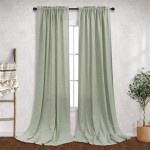How to Put Up Curtain Rods Without Drilling Holes
Hanging curtains is a common step in decorating a home, providing privacy, light control, and aesthetic enhancement. While the traditional method involves drilling holes to install curtain rod brackets, this can be undesirable for renters, those concerned about damaging walls, or individuals looking for a quick and easy solution. Fortunately, alternative methods exist that allow for the installation of curtain rods without the need for drilling, minimizing potential damage and simplifying the process.
This article explores various methods for hanging curtain rods without drilling, outlining the tools, techniques, and considerations for each approach. Understanding these alternatives empowers individuals to enhance their living spaces without committing to permanent alterations.
Using Tension Rods
Tension rods are a readily available and practical solution for hanging curtains without drilling. These rods utilize spring tension to stay in place, pressing against the inside of the window frame or between two walls. The simplicity of their installation and removal makes them an attractive option for temporary or rental situations.
The first step is to accurately measure the inside width of the window frame or the distance between the walls where the curtain rod will be installed. This measurement is crucial for selecting a tension rod that fits appropriately. Tension rods are typically adjustable within a specific range, so choosing one that encompasses the measured distance is essential.
Once the appropriate tension rod is selected, it is necessary to prepare the surface where the rod will be placed. Cleaning the inside of the window frame or the walls with a damp cloth and mild cleaner removes any dirt or grease that may impede the rod's grip. Ensuring the surfaces are clean and dry will maximize the rod's holding power and prevent slippage.
To install the tension rod, compress the spring mechanism and position the rod within the window frame or between the walls. Slowly release the pressure, allowing the spring to expand and create tension. Adjust the rod until it is level and securely in place. It is important to test the rod's stability by gently pulling on it to ensure it is firmly seated. If the rod slips, further adjustments may be needed to increase the tension.
When selecting curtains for use with tension rods, it is advisable to choose lightweight fabrics. Heavier curtains can place excessive strain on the rod, increasing the likelihood of slippage. Opting for lightweight materials ensures the tension rod can adequately support the weight of the curtains without compromising its stability. Regular checks of the tension and position of the rod are recommended to ensure its continued secure placement.
Leveraging Adhesive Hooks and Brackets
Adhesive hooks and brackets offer an alternative means of hanging curtain rods without drilling. These products utilize strong adhesive backings to adhere to the wall surface, providing a support point for the curtain rod. This method is particularly suitable for smooth, non-porous surfaces such as painted walls or glass.
Before applying adhesive hooks or brackets, it is essential to thoroughly clean the wall surface. Using a mixture of rubbing alcohol and water, wipe down the area where the hooks or brackets will be placed. This removes any dirt, grease, or residue that could interfere with the adhesive bond. Allowing the surface to dry completely is crucial for optimal adhesion.
Carefully position the adhesive hooks or brackets on the wall, ensuring they are level and spaced appropriately to accommodate the length of the curtain rod. Mark the desired locations with a pencil before removing the adhesive backing. This allows for precise placement and ensures the curtain rod will be hung straight.
Peel off the adhesive backing and firmly press the hooks or brackets onto the marked locations. Apply consistent pressure for the recommended duration specified by the manufacturer. This allows the adhesive to properly bond with the wall surface. Avoid applying excessive pressure, as this could damage the wall or the adhesive.
After installing the adhesive hooks or brackets, it is imperative to allow the adhesive to cure for the recommended time period, typically 24 to 48 hours. Refraining from hanging the curtain rod during this curing period allows the adhesive to fully bond with the wall surface, maximizing its strength and preventing premature failure. Once the curing period is complete, the curtain rod can be carefully placed onto the hooks or brackets. When selecting curtains for use with adhesive hooks or brackets, it is crucial to consider the weight capacity of the adhesive product. Overloading the hooks or brackets can result in them detaching from the wall, causing damage and posing a safety hazard.
Utilizing adhesive backed magnetic curtain rod holders can enable the mounting of curtain rods onto metal surfaces without drilling. These are typically used on metal doors or window frames. Make sure the surfaces are clean and dry before placing. The curtains used with this method should be lightweight.
Utilizing No-Drill Curtain Rod Systems
No-drill curtain rod systems are specifically designed to provide a drill-free installation solution. These systems often incorporate unique mounting mechanisms that attach to the window frame or wall without the need for screws or nails. These systems vary in design and mounting methods, but the core principle is to provide a stable and secure hold without causing damage to the wall.
Before purchasing a no-drill curtain rod system, carefully measure the window frame or the area where the curtain rod will be installed. This ensures that the chosen system is compatible with the dimensions of the space. It is also important to consider the weight and style of the curtains that will be hung, as different no-drill systems have varying weight capacities and aesthetic designs. Some no-drill systems are designed for specific window types, such as casement or double-hung windows, while others are more versatile and can be used with a wider range of window styles.
Each no-drill curtain rod system comes with specific installation instructions that should be followed meticulously. These instructions typically involve cleaning the mounting surface, attaching the mounting brackets to the window frame or wall using adhesive strips or tension mechanisms, and then placing the curtain rod onto the brackets. Adhering to the manufacturer's instructions is crucial for ensuring a secure and stable installation. It is also important to pay attention to any weight restrictions or recommendations provided by the manufacturer.
Regularly inspect the no-drill curtain rod system to ensure it remains securely mounted. Over time, the adhesive or tension mechanisms may weaken, requiring adjustments or replacement of the mounting components. Addressing any signs of instability promptly can prevent the system from failing and potentially causing damage or injury. It's also wise to consider the type of curtains being hung. Heavy, lined curtains place more stress on the system compared to light, sheer curtains. Choosing lighter-weight curtains will prolong the life and stability of the no-drill system.
When removing a no-drill curtain rod system, it is essential to do so carefully to avoid damaging the wall or window frame. Adhesive strips can often be removed by gently heating them with a hairdryer and then slowly peeling them away from the surface. Tension mechanisms should be released gradually to prevent sudden stress on the surrounding areas. Cleaning any residual adhesive or marks left behind after removal will help restore the wall or window frame to its original condition.
When selecting the right approach for hanging curtains without drilling, it's important to consider the specific needs of the situation. Temporary solutions in rental properties might benefit from tension rods or easily removable adhesive options. For more permanent installations, no-drill systems designed for specific window types could offer a more robust solution. Careful planning and attention to the weight of the curtains will help ensure a successful and aesthetically pleasing result.
Furthermore, consider the aesthetic impact of each method. While tension rods are functional, they might not be the most visually appealing option for all décor styles. Adhesive hooks and brackets, if visible, should complement the overall design of the room. No-drill curtain rod systems often offer a more polished and integrated look, blending seamlessly with the window and curtains.
Always test the stability of any non-drilling curtain rod installation before fully trusting it with heavier curtains. Gently apply pressure to the rod to ensure it is firmly secured and can withstand the weight of the fabric. Regular maintenance and inspections will help identify any potential issues before they escalate into problems.

How To Hang Curtains Without Drilling

4 Easy Ways To Hang Curtains Without Drilling

How To Hang A Curtain Rod Without Drilling Into The Wall

4 Easy Ways To Hang Curtains Without Drilling

How To Hang Curtains Using Command Hooks The Happier Homemaker

4 Easy Ways To Hang Curtains Without Drilling

How To Hang Curtains Without Drilling 8 Creative Ideas Hanging Curtain Rods

How To Hang Curtains Without Making Holes In The Wall Interior Design Wonderhowto

How To Hang A Curtain Rod Without Drilling Into The Wall

How To Hang Curtains Without Drilling








